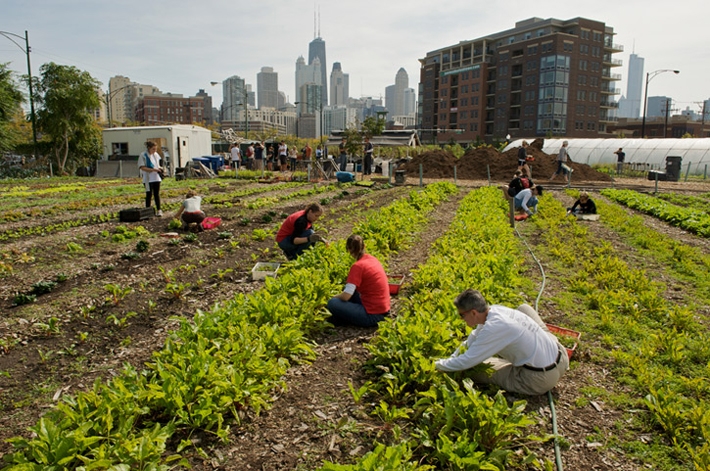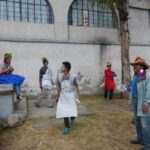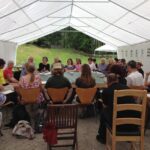On “A Lived Practice” Symposium, School of the Art Institute of Chicago, Nov. 6-8, 2014
Megan Voeller
“A Lived Practice,” was a program at the School of the Art Institute of Chicago that included a symposium, an exhibition, and other events during the fall of 2014. It intended to claim a place for Chicago—and, specifically, for SAIC—in the emerging canon of social practice art. Chicago has promising ground on which to build such a narrative: it has a heritage of experimental education and social reform fused with aesthetics in the persons of Jane Addams and John Dewey, along with a spate of contemporary artists invested in projects intended to affect social change. However, attendees of the three-day symposium “A Lived Practice” (Nov. 6-8, 2014) would have walked away with little sense of either: in its attempt to address big and moralizing ideas surrounding the experience of working as a socially engaged artist (e.g., how to cultivate a life practice of “heightened consciousness and awareness,” according to the program website), the symposium declined to provide more than a few concrete connections to actual, artist-led projects and altogether eschewed taking on questions of meaning, methodology, ethics, evaluation and sustainability that have been invoked by many as critical to the discipline.

The root of the problem seemed to be that key speakers had little understanding of what constitutes social practice, debates surrounding how to define social practice within contemporary art, or the discipline’s complex relationships to other 20th and 21st century approaches to art making. Lewis Hyde, the symposium’s opening keynote and author of The Gift: Imagination and the Erotic Life of Property, issued an erudite call to consider “the common self” in the context of cultural production. He noted that luminaries such as Benjamin Franklin, Bob Dylan and Martin Luther King, Jr. had leaned heavily on predecessors, collaborators and cultural context—in effect discovering themselves and their creative insights in others, to varying degrees. Hyde took as his rhetorical target an American legal and philosophical tradition that asserts the rights, property and creativity of individuals. In contrast, he valorized a less bounded, more collaborative self, knowingly intertwined with others as well as a cultural and natural commons. As an artistic illustration of the concept, he pointed to his own collaboration with painter Max Gimblett, Oxherding: A Buddhist Parable, on view at SAIC’s Sullivan Galleries. The project paired Gimblett’s minimal ink-and-brush paintings with Hyde’s translation of a 12th century Chinese poem to depict the enlightenment of a wandering ox herder who gradually realizes the fundamental unity of all things.
Hyde’s learned talk—a liberal arts chestnut—felt oddly matched with an audience immersed in social practice and its attendant concerns. At its most basic level, the idea he espoused of a self interwoven with others and context cannot have come as new information to anyone with prior exposure to the concept of a sociology of knowledge (embedded in much contemporary critical theory): that reality is co-constructed through communal participation is typically a jumping off point, even if a tacit one, for artistic endeavors that seek to effect social change and build solidarity. However, with varying degrees of intention, such projects operate on the basis of social difference more than commonality. They leverage the privilege of an artist and his or her access to capital of some kind—class, gender or racial privilege; cultural or reputation capital; funding or fundability—to extend resources to a community that does not have access to the same, frequently due to real and persistent inequity. (When artists are less privileged and have more in common with participants, their activities are more often framed as community arts than social practice, a more rarified and academic designation—this distinction is itself a hot topic of contention.) A troubling question about social practice is the extent up to which professional artists in an authorship role benefit from the unpaid and sometimes under-informed participants they putatively serve, collaborate with or engage with in their art, as the artist accumulates still further capital through exhibitions, reviews, awards, etc.: by doing the project that participants do not. In the context of this discussion, Hyde’s rallying cry for a common self sounded utterly well meaning but surprisingly simplistic.
For the public, the second day of the symposium consisted only of a reception for the exhibition A Proximity of Consciousness: Art and Social Action at SAIC’s Sullivan Galleries. But for a select group of about 90 artists, activists, curators and students chosen by the conference organizers, it entailed additional sessions. These included a communal lunch—itself one of a series of meals conceived by Rirkrit Tiravanija as a piece for the exhibition—which took place inside Pablo Helguera’s Addams-Dewey Gymnasium, a large room where visitors were later invited to take part in gentle physical exercises in a bland homage to the two namesakes. After lunch, half a dozen artists and curators, including Alistair Hudson (director of the Middlesbrough Institute of Modern Art), Yasmil Raymond (curator at Dia Art Foundation), and Sarah Ross (core organizer of the Chicago area Prison + Neighborhood Arts Project), spoke about their own work or issues surrounding social practice in general. However, each was limited to five minutes with no visual aids, which made real discussion or sharing almost impossible. Daniel Joseph Martinez put his time to the best critical use: he called on the group to stop conflating social practice with doing good and to develop better means of evaluating work under this problematic label. “This is a back alley fight for history,” he warned. After lunch, breakout sessions included one where participants were tasked with discussing empathy—specifically, “the choreography of empathy”—as related to social practice, a topic introduced with minimal explanation. I was not part of the invited group and attended this day of the conference by accident, ushered into lunch by a friendly SAIC staffer who seemed as confused as I was.
Day Three returned to a public forum. A Lived Practice organizer Mary Jane Jacob, a SAIC professor and well-known curator specializing in social practice, took to the auditorium stage to explain that the goal of the symposium was not to analyze or sum up social practice but to offer “insights from which we can feed the future”, as if seeking to adjust expectations retroactively. Immediately after, Crispin Sartwell delivered an appeal to dissolve elitist barriers between fine art and commercial culture. His words came as a wild misfire to the crowd. As an example, he argued that Taylor Swift songs and performances have inspired grassroots forays into aesthetic experience, such as YouTube homages by young girls, thereby enriching everyday life in the vein of fine art, if not with greater influence. The banality of this point and the tired dichotomy underlying it seemed to truly offend the audience, which heckled Sartwell. Like Hyde, but vastly more so, he seemed unaware of the complexity of the context in which he was speaking—for instance, of the historical dependence of forms of avant-garde art, now including social practice, on a golden umbilical cord of market and institution support. Especially in the work of its marquee practitioners, such as Theaster Gates (whose name was not invoked once during the symposium despite being Chicago’s best known social practice artist), social practice has been deeply invested in creating a market for itself, or its byproducts, rather than eschewing commerce. A question faced by young social practice artists is not just how to bring aesthetic experience to bear on everyday life, i.e., how to do social practice, but how to navigate a market-institutional system in which bringing aesthetics to bear on everyday life is to some degree a desirable commodity.
Ken Dunn, founder of the Chicago nonprofit Resource Center and its programs in recycling and urban farming, offered an inspiring reflection on his career that hit neatly on the symposium’s desired communication: find your passion to serve others and make a difference by living it every day. After Dunn, art historian Wolfgang Zumdick performed a virtuoso unpacking of the utopian symbolism behind a cryptic chalkboard drawing created by Joseph Beuys during a 1974 lecture at SAIC. While fascinating, this felt like an obligatory devotion to an object held in the Art Institute of Chicago’s collection.
The exception to the symposium’s reluctance to address social practice head-on was a remarkable concluding presentation by Ernesto Pujol. The artist gave a four-part monologue describing several of his spiritually inflected performance projects including Speaking In Silence. The work is a 2011 collaboration with eighteen Honolulu residents (accompanied by Pujol) who processed through historical sites in the city, mostly in monastic silence, to stimulate reflection and communion with the place. The format of Pujol’s talk was itself languorously performative—he sat in the dark on a spotlighted chair and narrated a slideshow of arresting color photographs of the projects, punctuating his speech with silence and using props in theatrical segues. Rather than seeming affected, these details eloquently conveyed Pujol’s charismatic vulnerability, giving a sense of how interacting with him might be thought provoking, even transformative, for participants and observers. He peppered his narrative with searching questions and pronouncements on social practice, some of which veered into diva territory. “Please do not invite an artist if you don’t have a social practice as a curator,” he scolded suggesting that curators had sometimes under-supported his desire to build and maintain strong connections with project participants, which he described as a surrogate family. Other issues he raised felt vital and constructive: how much engagement with a community qualifies as engagement? How does social practice relate to social change? Are museums averse to contemporary art that “feels like faith”? What does it mean to conceive of one’s life as a site of practice (the under-interrogated premise of the conference)? But after dramatically introducing these volatile questions, Pujol concluded his performance without a Q&A period—as had been announced in advance, marking the end of the symposium. The moment felt emblematic of the symposium as a whole, which seemed timid of raising difficult questions and adamantly, even perversely, opposed to discussing them.
Megan Voeller is an art critic, curator and museum educator based in Tampa, Florida. She has written more than 250 exhibition reviews and feature stories for Creative Loafing as the weekly newspaper’s visual art critic and is a regular contributor to other publications. As Associate Curator and Art In Health Program Director at the University of South Florida Contemporary Art Museum, Voeller organizes exhibitions (A Family Affair, 2015; Making Sense: Rochelle Feinstein, Deborah Grant, Iva Gueorguieva, Dona Nelson, 2014, co-curated with director Margaret Miller) and interdisciplinary educational programs including a series of observation training workshops for students in healthcare professions. She also co-hosts WEDU Arts Plus, a public television program produced by PBS affiliate WEDU. Voeller holds a BA in studio art from Williams College, an MA in media studies from the New School and an MA in art history from the University of South Florida.






